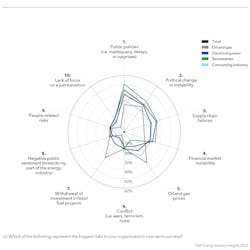Energy transition faces climate crossroads
By Pedram Fanailoo, DNV
Of more than 1,300 senior energy professionals surveyed, nearly three-quarters (71%) said policy failures are holding back greater action on climate change. This risk to near-term success includes public policies being delayed, inadequate or unexpected, which are further compounded by political change or instability.
Lack of political support and challenges surrounding permitting and licensing are the greatest barriers to renewable growth, which 88% of respondents believe are critical to meeting climate goals. Other significant risks shared include supply chain failures and financial market instabilities (Figure 2).
Early estimates suggest that the Inflation Reduction Act (IRA) will add up to 550 GW of “new, utility-scale clean power” from 2022-2030. It remains to be seen whether this new legislation in the US, alongside the Green Deal Industrial Plan in the EU, will stimulate rather than debilitate faster action on climate change.
Revolutionizing offshore energy
Time is not an ally of those in power. The IPCC report calls for carbon pollution and fossil fuel use to be slashed by nearly two-thirds within 12 years.
Few in the energy industry (17%) believe the transition will deliver secure, clean and affordable energy in the next decade, to all parts of the energy system in their country. Most (41%) see this being achieved in 10 to 20 years, while a sizable group (32%) believe this crucial outcome of the energy transition will not be realized until well into the 2040s—only energy professionals in North America are slightly more conservative on the timeline.
The offshore energy sector can play a transformative role in achieving energy transition ambitions. In 2030, DNV forecasts that 140 GW of off-grid renewables will provide 50% of world hydrogen supply, split almost evenly between solar and wind. This low-cost energy resource can provide dedicated off-grid support for energy islands to produce clean hydrogen to support multi-industry decarbonization.
Much of the existing offshore infrastructure can be adapted to support hydrogen production. For example, the Re-Stream project, concluded that most offshore pipelines can be reused for pure hydrogen based on the current state of knowledge and standards. Likewise, offshore gas turbines using waste heat recovery units represents a highly efficient power resource that can be used to support CCS operations.
Collaborative, principles-based regulations
Despite transition progress offshore, less than half (39%) of energy professionals are confident about meeting their own organizations decarbonization and climate targets.
Greater cooperation between stakeholders—with regulators and government at the top of the list—is needed to urgently unlock bottlenecks and upscale meaningful low-carbon solutions. For instance, while the IRA has done much to promote the production side of clean energy (i.e., hydrogen production is much cheaper), the consumption side still has more room for improvement to incentivize the move away from carbon-intensive fuels. Likewise, nimbyist fears around transportation should be addressed and alleviated to instill pace to the permissions process.
The challenge with policy and regulation is akin to the issues around capital allocation and the energy transition more broadly: we don’t have it all worked out and agreed in advance. For regulators, this must lead to a shift toward less prescriptive, and more principles-based governance, so rulings can be made on future issues that legislators cannot yet foresee in high definition.
DNV’s latest Energy Transition Outlook report, expected to be published imminently, will provide crucial insight and intelligence to shape decisions and galvanize action now and toward mid-century.



